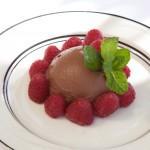Wolfberger Crémant d’Alsace Brut Rosé
Alsace is located in northeastern France. It’s so far north that the wine grapes of the region may remind you more of neighboring Germany. Riesling, Gewürztraminer, Sylvaner, Pinot Blanc. Mostly white wines with the occasional light-bodied Pinot Noir.
It seemed appropriate to end our three-part visit to Alsace with my favorite kind of bubbles, Crémant d’Alsace brut rosé. Is anyone else out there in a pink bubbly state of mind?
NV Wolfberger, Crémant d’Alsace Brut Rosé, Alsace, France
Wine of the Week with Annette Tomei
Champagne is made by a process known as methode traditionelle. This ‘traditional method’ involves a primary fermentation of the wine in tank or barrel. Then a secondary fermentation takes place in the bottle. That’s where the bubbles come from.
Crémant d’Alsace
In France, they use the term crémant to describe sparkling wines of particular regions. Eight French wine regions have a version of their own, including Crémant d’Loire, d’Bourgogne, and d’Limoux. And, of course, Crémant d’Alsace.
Alsace is nearly next door to Champagne. It may be similar in climate, but its terroir is unique. And some pretty amazing bubbles come from here. In fact, Crémant d’Alsace is second only to its famous neighbor, as far as French sparklers go.
Sparkling wine first came to the region in 1900. Upon return from the Paris Exhibition, Alsatian vintner Julien Dopff began making bubbles. At first he made them with fruit imported from Champagne. Later he discovered he could make them from his own grapes. The style has been around ever since. All the region’s grapes can be used in making Crémant d’Alsace, including Pinot Noir. Winemakers may also use Chardonnay, the classic white grape of Champagne.
Crémant d’Alsace is not only a descriptor but the name of the appellation founded in 1976. The grapes can come from anywhere in Alsace. Many producers here have a sparkling wine in their portfolio. In fact, about a quarter of the wines from Alsace claim this AOC.
Why wine lovers should appreciate pink bubbles
It’s no secret, we are all a bunch of bubbly lovers here. My personal favorite are pink bubbles in the form of brut rosé. Crémant d’Alsace AOC requires its Brut Rosé be made with 100% Pinot Noir grown within Alsace.
Like good still rosés, the color comes from a process called saignée (meaning ‘to bleed’). After pressing, the grape juice is left in cold contact with the skins to bleed off some color. The skins are then removed, and the juice is fermented alone (similar to white wine).
The process provides flavor and texture components as well as the color. This gives brut rosés flavors and aromas that tend more toward the darker end of the spectrum – berries, plums, and spice. Between this and the slightly elevated body, it makes these dry pink bubbles delightful dining companions for more substantial dishes, even red meats.
What is Wolfberger?
Wolfberger is not a single producer, but a union of many. It was founded by a group of growers from the Eguisheim area in 1902. It was one of the first wine cooperatives in Alsace. Today it has approximately 450 member vineyards. Nearly half its current acreage is still in the original Eguisheim area. All regional grape varietals are represented with Riesling and Pinot Blanc being the top two. Since 2011, Wolfberger’s winemaking is overseen by Jerome Keller, who is also the winemaker at Lucien Albrecht.
Wolfberger also has a distillery that is known for its Kirsch (cherry), Framboise (raspberry), and Poire William (pear) liqueurs. They also produce 28 different fruit brandies, or eaux-de-vie.
 My review of Wolfberger Crémant d’Alsace Brut Rosé
My review of Wolfberger Crémant d’Alsace Brut Rosé
When you first pour a glass of Wolfberger Crémant d’Alsace, you’ll notice the pale salmon color and the frothiness of the mousse. Then the yeasty, fresh baked brioche aromas you may expect from a good sparkling wine. In this case, the brioche is accompanied by red ripe raspberries with a hint of spice. I also picked up notes of almond paste and baked apple.
On the first sip you’ll notice a full round mouthfeel and the most delicate mousse. Part of that mouthfeel comes from the almost imperceptible residual sugar. At 9 grams per liter it is just above the threshold of detecting sweetness (6 grams/liter). The round mouthfeel is balanced by plenty of acidity and a touch of astringency. Flavors of red fruit, almond, and rhubarb also finished with a wisp of Persian spices.
Because of its body and balanced acid and astringency, I tasted this wine with a dish I would normally have saved for a red wine. The Wolfberger Crémant d’Alsace brut rosé stood its ground with my braised short rib ragout on pasta. I was happy with the pairing. For a more classic approach, try the easier and much more romantic poached salmon in rosé wine sauce. Or, for a vegetarian option try this minted bulgur salad with pine nuts and feta (it also makes a great side dish).
Where to buy Wolfberger Crémant d’Alsace Brut Rosé
As of the time of publication, I was able to find this wine online from Wine.com, Drizzly, and Timeless Wines.
This concludes or visit to Alsace. If you missed the first two wines of the series, you can find them my Gewurztraminer recommendation here and my Riesling recommendation here.
- A Tequila Hot Toddy Recipe - January 24, 2025
- Spiced Tart Cherry Juice Mocktail (Mock Glögg) - November 8, 2024
- The Best Whole Grain Grilled Cheese with Pickles - September 30, 2024


 My review of Wolfberger Crémant d’Alsace Brut Rosé
My review of Wolfberger Crémant d’Alsace Brut Rosé



Leave a Reply
Want to join the discussion?Feel free to contribute!